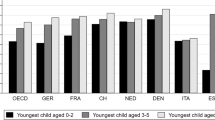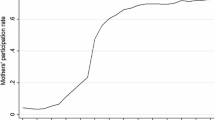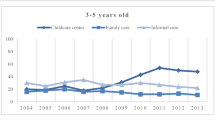Abstract
Early care and education (ECE) enables parental employment and provides a context for child development. Theory suggests that lower child care costs, through subsidized care or the provision of free or low-cost arrangements, would increase the use of ECE and parents’ employment and work hours. This paper reviews the research literature examining the effects of child care costs and availability on parental employment. In general, research suggests that reduced out-of-pocket costs for ECE and increased availability of public ECE increases ECE attendance among young children, and has positive impacts on mothers’ labor force participation and work hours. However, there is considerable heterogeneity in findings. Among U.S. studies that report the elasticity of employment to ECE price, estimates range from −0.025 to −1.1, with estimates clustering near 0.05–0.25. This indicates that a 10 % reduction in the price of child care would lead to a 0.25–11 % increase in maternal employment, likely near 0.5–2.5 %. In general, studies using more recent data or data from non-U.S. countries find smaller elasticities than those using U.S. data from the 1990s. These differences may be due to historical and cross-national differences in ECE attendance, labor force attachment, and educational attainment among mothers with young children, as well as heterogeneity in the methodological approaches and data used across studies. More research in the U.S. using contemporary data is needed, particularly given recent changes in U.S. ECE policy.
Similar content being viewed by others
Notes
Source: 2011 Survey of Income and Program Participation (SIPP).
References
Bainbridge, J., Meyers, M. K., & Waldfogel, J. (2003). Child care reform and the employment of lone mothers. Social Science Quarterly, 84(4), 771–791.
Baker, M. (2011). Innis lecture: Universal early childhood interventions: What is the evidence base? Canadian Journal of Economics, 44(4), 1069–1105. doi:10.1111/j.1540-5982.2011.01668.x.
Baker, M., Gruber, J., & Milligan, K. (2008). Universal child care, maternal labor supply, and family well-being. Journal of Political Economy, 116(4), 709–745.
Barnett, W. S. (2011). Effectiveness of early educational intervention. Science, 333(6045), 975–978. doi:10.1126/science.1204534.
Baum, C. L. (2002). A dynamic analysis of the effect of child care costs on the work decisions of low-income mothers with infants. Demography, 39(1), 139–164.
Berlinski, S., & Galiani, S. (2007). The effect of a large expansion of pre-primary school facilities on preschool attendance and maternal employment. Labour Economics, 14(3), 665–680. doi:10.1016/j.labeco.2007.01.003.
Berlinski, S., Galiani, S., & McEwan, P. J. (2009). Preschool and maternal labour market outcomes: Evidence from a regression discontinuity design. Economic Development and Cultural Change, 59(2), 313–344.
Bianchi, S. M. (2000). Maternal employment and time with children: Dramatic change or surprising continuity? Demography, 37, 401–414.
Blau, D. M. (2001). The child care problem: An economic analysis. New York: Russell Sage Foundation.
Blau, D. M., & Currie, J. (2006a). Preschool, day care, and after-school care: Who’s minding the kids? Handbook of the Economics of Education, 2, 1163–1278.
Blau, D. M., & Currie, J. (2006b). Who’s minding the kids? Preschool, day care, and afterschool care. In Handbook of the economics of education. New York: North Holland.
Blau, F. D., & Kahn, L. M. (2007). Changes in the labor supply behavior of married women: 1980–2000. Journal of Labor Economics, 25(3), 393–438. doi:10.1086/513416.
Blau, D. M., & Tekin, E. (2007). The determinants and consequences of child care subsidies for single mothers in the USA. Journal of Population Economics, 20, 719–741. doi:10.1007/s00148-005-0022-2.
Brilli, Y., Boca, D., & Pronzato, C. D. (2016). Does child care availability play a role in maternal employment and children’s development? Evidence from Italy. Review of Economics of the Household, 14(1), 27–51. doi:10.1007/s11150-013-9227-4.
Brilli, Y., Del Boca, D., & Pronzato, C. (2011). Exploring the impacts of public childcare on mothers and children in Italy: Does rationing play a role? Working Paper (5918). Retrieved from http://ftp.iza.org/dp5918.pdf.
Brooks-Gunn, J., McCormick, M. C., Shapiro, S., Benasich, A., & Black, G. W. (1994). The effects of early education intervention on maternal employment, public assistance, and health insurance: The infant health and development program. American Journal of Public Health, 84(6), 924–931. doi:10.2105/AJPH.84.6.924.
Bureau of Labor Statistics. (2015). Employment characteristics of families summary. U.S. Department of Labor. Retrieved December 15, 2015, from http://www.bls.gov/news.release/famee.nr0.htm.
Cannon, J. S., Jacknowitz, A., & Painter, G. (2006). Is full better than half? Examining the longitudinal effects of full-day kindergarten attendance. Journal of Policy Analysis and Management, 25(2), 299–321. doi:10.1002/pam.
Cascio, E. U. (2009). Maternal labor supply and the introduction of kindergartens into american public schools. Journal of Human Resources, 44(1), 140–170. doi:10.1353/jhr.2009.0034.
Cascio, E. U., & Schanzenbach, D. W. (2013). The impacts of expanding access to high-quality preschool (pp. 127–178). Fall: Brookings Papers on Economic Activity.
Child Care Aware. (2014). Parents and the high cost of child care. VA: Arlington.
Compton, J., & Pollak, R. A. (2014). Family proximity, childcare, and women’s labor force attachment. Journal of Urban Economics, 79, 72–90. doi:10.1016/j.jue.2013.03.007.
Connelly, R., & Kimmel, J. (2003). The effect of child care costs on the employment and welfare recipiency of single mothers. Southern Economic Journal, 69(3), 498–519.
Council of Economic Advisors. (2014). Nine facts about American families and work. Washington, DC. Retrieved from https://www.whitehouse.gov/sites/default/files/docs/nine_facts_about_family_and_work_real_final.pdf.
Crosby, D. A., Gennetian, L. A., & Huston, A. C. (2005). Child care assistance policies can affect the use of center-based care for children in low-income families. Applied Developmental Science, 9, 86–106.
Datta Gupta, N., Smith, N., & Verner, M. (2008). Perspective article: The impact of Nordic countries’ family friendly policies on employment, wages, and children. Review of Economics of the Household, 6(1), 65–89. doi:10.1007/s11150-007-9023-0.
de la Cruz Toledo, E. (2015). Universal preschool and mothers’ employment. New York, NY: Columbia Population Research Center Working Paper.
Del Boca, D. (2002). The effect of child care and part time opportunities on participation and fertility decisions in Italy. Journal of Population Economics, 15, 549–573. doi:10.1007/s001480100089.
Del Boca, D., Pasqua, S., & Pronzato, C. (2009). Motherhood and market work decisions in institutional context: A European perspective. Oxford Economic Papers, 61(Supplement 1), i147–i171. doi:10.1093/oep/gpn046.
Doiron, D., & Kalb, G. (2002). Demand for childcare services and labour supply in Australian families. The Australian Economic Review, 35(2), 204–213. doi:10.1111/1467-8462.00237.
Doiron, D., & Kalb, G. (2005). Demands for child care and household labour supply in Australia. Economic Record, 81, 215–236. doi:10.1111/j.1475-4932.2005.00257.x.
Fitzpatrick, M. D. (2010). Preschoolers enrolled and mothers at work? The effects of universal prekindergarten. Journal of Labor Economics, 28(1), 51–85. doi:10.1086/648666.
Fitzpatrick, M. D. (2012). Revising our thinking about the relationship between maternal labor supply and preschool. Journal of Human Resources, 47(3), 583–612. doi:10.1353/jhr.2012.0026.
Forry, N. D., & Hofferth, S. L. (2011). Maintaining work: The influence of child care subsidies on child care-related work disruptions. Journal of Family Issues, 32, 346–368. doi:10.1177/0192513X10384467.
Francesconi, M., & van der Klaauw, W. (2007). The socioeconomic consequences of “In-Work” benefit reform for British lone mothers. Journal of Human Resources, 42(1), 1–31. doi:10.3368/jhr.XLII.1.1.
Galinsky, E., Bond, J. T., Sakai, K., Kim, S., & Giuntoli, N. (2008). National study of employers. New York: Families and Work Institute.
Gelbach, J. B. (2002). Public schooling for young children and maternal labor supply. American Economic Review, 92(1), 307–322. doi:10.1257/000282802760015748.
Gennetian, L. A., Crosby, D. A., Huston, A. C., & Lowe, E. D. (2004). Can child care assistance in welfare and employment programs support the employment of low-income families? Journal of Policy Analysis and Management, 23(4), 723.
Geyer, J., Haan, P., & Wrohlich, K. (2014). The effects of family policy on mothers’ labor supply: Combining evidence from a structural model and a natural experiment. Labour Economics, 36, 84–98. doi:10.1016/j.labeco.2015.07.001.
Gordon, R. A., & Högnäs, R. S. (2006). The best laid plans: Expectations, preferences, and stability of child-care arrangements. Journal of Marriage and Family, 68(2), 373–393. doi:10.1111/j.1741-3737.2006.00259.x.
Gordon, R. A., Kaestner, R., & Korenman, S. (2008). Child care and work absences: Trade-offs by type of care. Journal of Marriage and Family, 70(1), 239–254. doi:10.1111/j.1741-3737.2007.00475.x.
Gormley, W. T., Gayer, T., Phillips, D. A., & Dawson, B. (2005). The effects of universal pre-K on cognitive development. Developmental Psychology, 41(6), 872–884. doi:10.1037/0012-1649.41.6.872.
Gornick, J. C., & Meyers, M. (2003). Families that work: Policies for reconciling parenthood and employment. New York: Russell Sage Foundation.
Ha, Y., Magnuson, K. A., & Ybarra, M. (2012). Patterns of child care subsidy receipt and the stability of child care. Children and Youth Services Review, 34(9), 1834–1844. doi:10.1016/j.childyouth.2012.05.016.
Haan, P., & Wrohlich, K. (2011). Can child care policy encourage employment and fertility? Evidence from a structural model. Labour Economics, 18(4), 498–512. doi:10.1016/j.labeco.2010.12.008.
Halpern, D. F. (2005). Psychology at the intersection of work and family: Recommendations for employers, working families, and policymakers. American Psychologist, 60, 397–409.
Han, W.-J., & Waldfogel, J. (2001). Child care costs and women’s employment: A comparison of single and married mothers with pre-school-aged children. Social Science Quarterly, 82(3), 552–568. doi:10.1111/0038-4941.00042.
Hanappi, T. P., & Müllbacher, S. (2013). Tax incentives and family labor supply in Austria. Review of Economics of the Household,. doi:10.1007/s11150-013-9230-9.
Hardoy, I., & Schøne, P. (2013). Enticing even higher female labor supply: The impact of cheaper day care. Review of Economics of the Household, 123, 1–22. doi:10.1007/s11150-013-9215-8.
Havnes, T., & Mogstad, M. (2010). Is universal child care leveling the playing field? Evidence from non-linear difference-in-differences. Journal of Public Economics. doi:10.1016/j.jpubeco.2014.04.007.
Havnes, T., & Mogstad, M. (2011a). Money for nothing? Universal child care and maternal employment. Journal of Public Economics, 95(11–12), 1455–1465. doi:10.1016/j.jpubeco.2011.05.016.
Havnes, T., & Mogstad, M. (2011b). No child left behind: Subsidized child care and children’s long-run outcomes. American Economic Journal: Economic Policy, 3(2), 97–129.
Heckman, J. J., & Masterov, D. V. (2004). The productivity argument for investing in young children. Invest in Kids Working Group.
Herbst, C. M. (2010). The labor supply effects of child care costs and wages in the presence of subsidies and the earned income tax credit. Review of Economics of the Household, 8, 199–230. doi:10.1007/s11150-009-9078-1.
Herbst, C. M. (2013). Universal child care, maternal employment, and children’s long-run outcomes: Evidence from the U.S. Lanham Act of 1940 (No. 7846). Retrieved from http://papers.ssrn.com/sol3/papers.cfm?abstract_id=2374627.
Herbst, C. M., & Tekin, E. (2011). Child care subsidies and childhood obesity. Review of Economics of the Household, 9, 349–378. doi:10.1007/s11150-010-9087-0.
Herbst, C. M., & Tekin, E. (2016). The impact of child-care subsidies on child development: Evidence from geographic variation in the distance to social service agencies. Journal of Policy Analysis and Management, 35(1), 94–116. doi:10.1002/pam.
Hofferth, S. L. (1999). Child care, maternal employment and public policy. The ANNALS of the American Academy of Political and Social Science, 563, 20–38. doi:10.1177/000271629956300102.
Hofferth, S., & Collins, N. (2000). Child care and employment turnover. Population Research and Policy Review, 19(4), 357.
Johnson, A. D., Martin, A., & Brooks-Gunn, J. (2013). Child-care subsidies and school readiness in kindergarten. Child Development, 84(5), 1806–1822. doi:10.1111/cdev.12073.
Johnson, A. D., Martin, A., & Ryan, R. M. (2014). Child-care subsidies and child-care choices over time. Child Development, 85(5), 1843–1851. doi:10.1111/cdev.12254.
Kalb, G. (2009). Children, labour supply and child care: Challenges for empirical analysis. Australian Economic Review, 42(3), 276–299. doi:10.1111/j.1467-8462.2009.00545.x.
Kalb, G., & Thoresen, T. O. (2010). A comparison of family policy designs of Australia and Norway using microsimulation models. Review of Economics of the Household, 8(2), 255–287. doi:10.1007/s11150-009-9076-3.
Kreyenfeld, M., & Hank, K. (2000). Does the availability of child care influence the employment of mothers? Findings from western Germany. Population Research and Policy Review, 19(4), 317.
Laughlin, L. (2013). Who’s minding the kids? Child care arrangements: Spring 2011 (Vol. 2009). U.S. Census Bureau: Washington, DC.
Lefebvre, P., & Merrigan, P. (2008). Child-care policy and the labor supply of mothers with young children: A natural experiment from Canada. Journal of Labor Economics, 26(3), 519–548. doi:10.1086/587760.
Lefebvre, P., Merrigan, P., & Roy-desrosiers, F. (2011). Quebec’s childcare universal low fees policy 10 years after: Effects, costs, and benefits. Montreal: Cirpee Working Paper 11-01.
Lefebvre, P., Merrigan, P., & Verstraete, M. (2009). Dynamic labour supply effects of childcare subsidies: Evidence from a Canadian natural experiment on low-fee universal child care. Labour Economics, 16(5), 490–502. doi:10.1016/j.labeco.2009.03.003.
Li, W., Farkas, G., Duncan, G. J., Burchinal, M. R., & Vandell, D. L. (2013). Timing of high-quality child care and cognitive, language, and preacademic development. Developmental Psychology, 49(8), 1440–1451. doi:10.1037/a0030613.
Loft, L. T. G., & Hogan, D. (2014). Does care matter? Care capital and mothers’ time to paid employment. Journal of Population Research, 31(3), 237–252. doi:10.1007/s12546-014-9133-5.
Mahringer, H., & Zulehner, C. (2015). Child-care costs and mothers’ employment rates: An empirical analysis for Austria. Review of Economics of the Household, 13(4), 837–870. doi:10.1007/s11150-013-9222-9.
Masse, L. N., & Barnett, W. S. (2002). A benefit cost analysis of the abecedarian early childhood intervention. New Brunswick, NJ. Retrieved from http://nieer.org/resources/research/AbecedarianStudy.pdf.
Matos, K., & Galinsky, E. (2014). National study of employers. New York, NY: Families and Work Institute.
McCartney, S., & Laughlin, L. (2011). Child care costs in the current population survey’s annual social and economic supplement (CPS ASEC): A comparison to SIPP (No. 2011-1). U.S. Census Bureau: Washington, DC. Retrieved from https://www.census.gov/hhes/povmeas/methodology/supplemental/research/ChildCareCPS.pdf.
Meyers, M. (1993). Child care in JOBS employment and training programs: What difference does quality make? Journal of Marriage and Family, 55, 593–603.
Meyers, M. K., Heintze, R., & Wolf, D. A. (2002). Child care subsidies and the employment of welfare recipients. Demography, 39, 165–179.
Michalopoulos, C. (2010). Effects of reducing child care subsidy copayments in Washington State. OPRE 2011-2. U.S. Department of Health and Human Services: Washington, DC. Retrieved from http://www.mdrc.org/publication/effects-reducing-child-care-subsidy-copayments-washington-state.
Michalopoulos, C., Lundquist, E., & Castells, N. (2010). The effects of child care subsidies for moderate-income families in Cook County, Illinois. Final Report. U.S. Department of Health and Human Services: Washington, DC. Retrieved from http://www.mdrc.org/publications/581/overview.html.
Milkie, M. A., Nomaguchi, K. M., & Denny, K. (2015). Does mom time matter? Does the amount of time mothers spend with children or adolescents matter? Journal of Marriage and Family, 77, 1–36. doi:10.1111/jomf.12170.
Morrissey, T. W., & Warner, M. E. (2007). Why early care and education deserves as much attention, or more, than prekindergarten alone. Applied Developmental Science, 11, 57–70. doi:10.1080/10888690701384897.
Morrissey, T. W., & Warner, M. E. (2011). An exploratory study of the impacts of an employer-supported child care program. Early Childhood Research Quarterly, 26(3), 344–354.
National Institute for Early Education Research. (2014). Florida voluntary prekindergarten program. Retrieved from http://nieer.org/sites/nieer/files/Florida_2014_1.pdf.
NICHD ECCRN. (2006). Child care effect sizes for the NICHD study of early child care and youth development. American Psychologist, 61, 99–116.
NSECE Team. (2014). Household search for and perceptions of early care and education: Initial findings from the national survey of early care and education (NSECE) (OPRE Report No. 2014-55a). Washington, DC. Retrieved from https://www.acf.hhs.gov/sites/default/files/opre/brief_hh_search_and_perceptions_to_opre_10022014.pdf.
OECD. (2015). Maternal employment rates. Paris, France. Retrieved from http://www.oecd.org/els/family/LMF_1_2_Maternal_Employment.pdf.
Office of the Assistant Secretary of Planning and Evaluation. (2015). Estimates of child care eligibility and receipt for fiscal year 2011. U.S. Department of Health and Human Services, Washington, DC. Retrieved from http://aspe.hhs.gov/hsp/15/ChildCareEligibility/ib_ChildCareEligibility.pdf.
Phillips, D. A., & Adams, G. (2001). Child care and our youngest children. The Future of Children, 11, 34–51.
Phillips, D. A., & Lowenstein, A. E. (2011). Early care, education, and child development. Annual Review of Psychology, 62, 483–500. doi:10.1146/annurev.psych.031809.130707.
Posadas, J., & Vidal-Fernandez, M. (2013). Grandparents’ childcare and female labor force participation. IZA Journal of Labor Policy, 2, 14. doi:10.1186/2193-9004-2-14.
Ruhm, C. J. (2011). Policies to assist parents with young children. The Future of Children, 21(2), 37–68. doi:10.1353/foc.2011.0015.
Ryan, R. M., Johnson, A., Rigby, E., & Brooks-Gunn, J. (2011). The impact of child care subsidy use on child care quality. Early Childhood Research Quarterly, 26(3), 320–331. Retrieved from http://www.sciencedirect.com/science/article/B6W4B-51PPSMP-2/2/80e5bb520816b1aa6b94012f8f73c17c.
Schlosser, A. (2011). Public preschool and the labor supply of Arab mothers: Evidence from a natural experiment. Working Paper. Tel Aviv University. Retrieved from http://www.tau.ac.il/~analias/Public%20PreSchool.pdf.
Stoney, L., Mitchell, A., & Warner, M. E. (2006). Smarter reform: Moving beyond single program solutions to an early care and education system. Community Development: Journal of the Community Development Society, 37, 101–115.
Tekin, E. (2007). Childcare subsidies, wages, and employment of single mothers. Journal of Human Resources, 42, 453–487. Retrieved from http://jhr.uwpress.org/content/XLII/2/453.short.
Vandell, D. L., McCartney, K., Owen, M. T., Booth, C., & Clarke-Stewart, A. (2003). Variations in child care by grandparents during the first three years. Journal of Marriage and Family, 65(2), 375–381. doi:10.1111/j.1741-3737.2003.00375.x.
Vandell, D. L., & Wolfe, B. (2000). Child care quality: Does it matter and does it need to beimproved?. Washington, DC: Office of the Assistant Secretary for Planning and Evaluation, U.S. Department of Health and Human Services.
Viitanen, T. K. (2005). Cost of childcare and female employment in the UK. Labour, 19(SUPPL. 1), 149–170. doi:10.1111/j.1467-9914.2005.00325.x.
Viitanen, T. K. (2011). Child care voucher and labour market behaviour: Experimental evidence from Finland. Applied Economics, 43(23), 3203–3212. doi:10.1080/00036840903508346.
Weiland, C., & Yoshikawa, H. (2013). Impacts of a prekindergarten program on children’s mathematics, language, literacy, executive function, and emotional skills. Child Development, 84(6), 2112–2130. doi:10.1111/cdev.12099.
Yoshikawa, H., Weiland, C., Brooks-Gunn, J., Burchinal, M. R., Espinosa, L. M., Gormley, W. T., et al. (2013). Investing in our future: The evidence base on preschool education investing in our future: The evidence base on preschool education. Washington, DC. Retrieved from http://www.srcd.org/sites/default/files/documents/washington/mb_2013_10_16_investing_in_children.pdf.
Ziliak, J. P., Hokayem, C., & Hardy, B. (2008). Child care subsidies and the economic well-being of recipient families: A survey and implications for Kentucky. Lexington, KY: University of Kentucky Center for Poverty Research.
Acknowledgments
This literature review was supported by the Division of Human Services Policy in the Office of the Assistant Secretary for Planning and Evaluation (ASPE), in the U.S. Department of Health and Human Services. The opinions and conclusions expressed herein are solely those of the author and should not be construed as representing the opinions or policies of the HHS or any agency of the Federal Government.
Author information
Authors and Affiliations
Corresponding author
Electronic supplementary material
Below is the link to the electronic supplementary material.
Rights and permissions
About this article
Cite this article
Morrissey, T.W. Child care and parent labor force participation: a review of the research literature. Rev Econ Household 15, 1–24 (2017). https://doi.org/10.1007/s11150-016-9331-3
Received:
Accepted:
Published:
Issue Date:
DOI: https://doi.org/10.1007/s11150-016-9331-3
Keywords
- Child care
- Early education
- Parent labor force participation
- Child care subsidies
- Child care costs
- Child care availability




